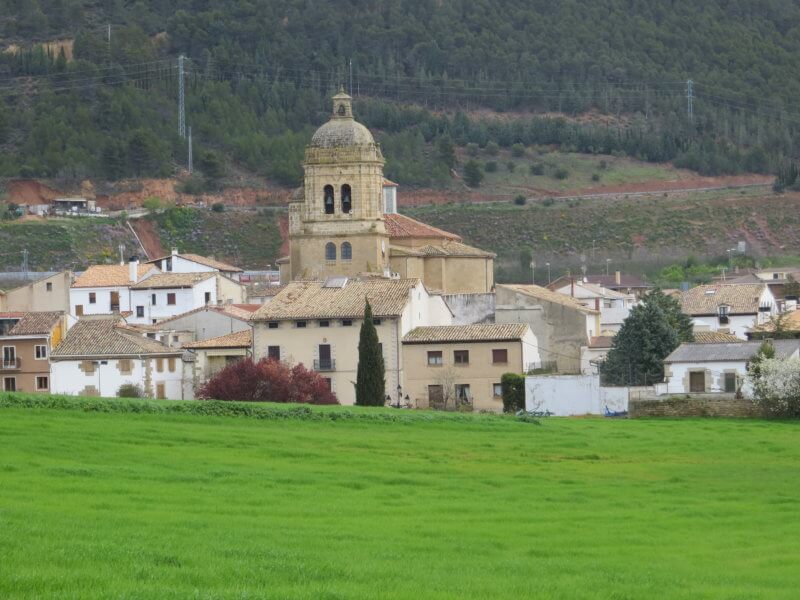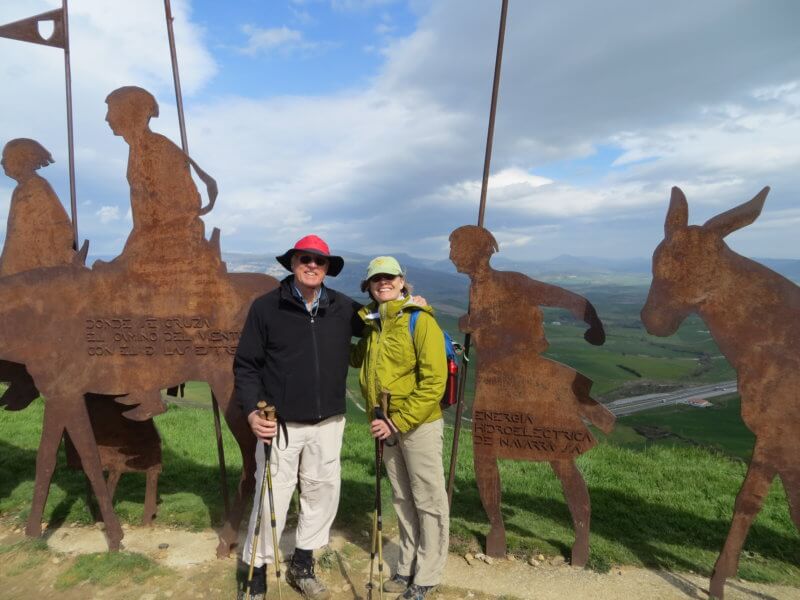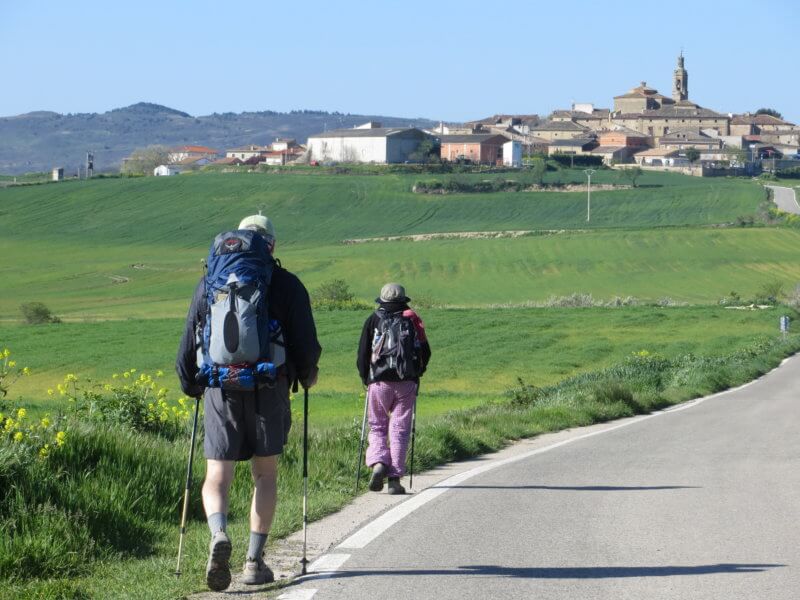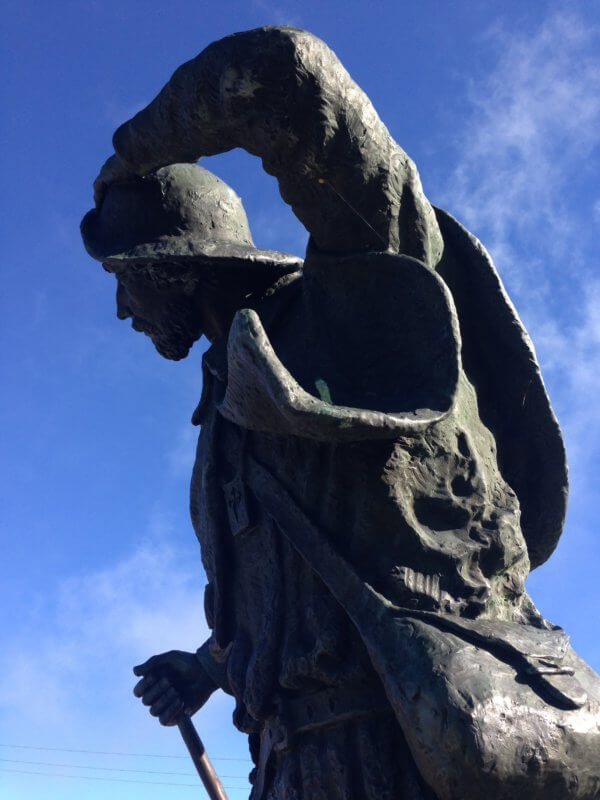Pilgrimage or hike — walking the Camino de Santiago
In the old days when someone went for a long walk, they called it a pilgrimage. Today they call it a hike — most of the time — but sometimes people still go for hikes that they call a pilgrimage.
When Tom McAuliff of Charlotte walked the Camino, officially the Camino de Santiago, it was a hike for him.

An example of the panoramic fields along the Camino with a village where travelers can find a place to stay.
But making that trek is still a pilgrimage for many walking the historic network of more than 10 trails that are paved with years of spiritual significance.
Pilgrimages to the cathedral of Santiago de Compostela in Galicia in northwestern Spain, where tradition says the remains of the apostle James are buried, are recorded back to at least the 9th century. But pilgrimages really picked up in 1492 when Pope Alexander VI declared the Camino de Santiago one of the three great Christian pilgrimages, along with Jerusalem and Rome.
In 2013, McAuliff and his wife Janella Pennington had planned to take 30 days for their hike on the Camino, but she took a bad fall at a remote bed and breakfast and they were in a bad way.
After getting medical treatment and the diagnosis that Pennington would need to be on crutches for at least three weeks, their hike on the Camino was over for that year.
But their problems were compounded because they’d been taken by a transport service for a remote area. And they had no idea where they were.

Tom McAuliff and Janella Pennington at the beginning of one of their adventures on the Camino at Alto del Perdón outside of Pamplona with its metal sculptures of pilgrims.
As they stepped out of a tourist office where they’d gone seeking advice, but found the attendants who had never heard of people with their problems and had no idea what McAuliff and Pennington should do, they ran into a group of six French Camino hikers they had met on their first day on the trail.
“We were rescued by a bunch of French hikers. I use the word ‘rescue’ because we didn’t know what to do. We didn’t know where to go. We didn’t know where we were in France,” McAuliff said.
The hikers took them under their wing and took them to their homes, where they stayed for a few days. McAuliff, Pennington and the group of French hikers became good friends.
For several years, until 2019, McAuliff and Pennington went back to France and hiked the Camino in sections when their French friends were hiking on their vacations.
Eventually, they completed the trail to the Camino de Santiago and beyond to the end at the coast of the Atlantic Ocean in Cape Finisterre, Spain. Finisterre is from the Latin for “end of the world.”
Now, their Camino days are done. Recently, McAuliff has been dispensing with his maps and guidebooks via social media.

Tom McAuliff and a French hiker they met along the way.
This is the hike featured in “The Way,” the 2010 movie featuring Martin Sheen, written and directed by his son Emilio Estevez. The film tells the story of a doctor who hikes the Camino after his son dies while hiking the route from France to Spain — except for the deceased son, it was a pilgrimage. In true Hollywood fashion, the father starts out on a hike that becomes a pilgrimage.
Since “The Way,” McAuliff said the numbers of those hiking or pilgrimaging have soared. More than 200,000 a year and growing by 10 percent annually, according to the internet.
“I did not hike it for a religious reason,” McAuliff said. “If you go into this thinking, ‘This will transform me,’ you’re probably better off transforming yourself in place, through therapy or some other things.”
More of a pilgrimage or a walk than a hike
Jane Horowitz, formerly of Charlotte and an advertising representative for The Charlotte News in the 1990s, hiked the Camino in 2013.
For her, the experience was more of a pilgrimage than a hike, but not in a traditional religious sense. And for Horowitz, who’s accustomed to traversing the steep trails of Vermont, the flatter route to Santiago de Compostela was more of a walk than a hike.

This is one of the many statues depicting
the pilgrim.
She was inspired to make the journey by the movie “The Way” and by the Shirley MacLaine book “The Camino: A Journey of the Spirit.” For MacLaine, the Camino experience was a pilgrimage and a spiritual quest.
Much of MacLaine’s book is about the history of the pilgrimage and the saints commemorated in the many churches along the way.
For Horowitz a big part of the Camino experience “was surrendering to the universe to allow whatever happened to happen.”
Before she went, Horowitz didn’t make reservations at places to stay along the way. “I just decided I was going to show up at a town and find a place to stay. So that was a surrender. I did not have everything planned and noted.”
It was an exercise in learning to live with the unknown, and Horowitz feels like she was changed by the experience. But it’s still a work in progress.
“It’s hard to surrender to the universe because we like to feel like we have control over things, but we don’t. That’s an illusion,” Horowitz said. “It was just a really uplifting, challenging, sweet and physical experience. It is all those things and an adventure.”
The year after hiking the Camino, she hiked the Long Trail, but in sections hiking on weekends.
Although the Long Trail was more of a hike, it had elements of a pilgrimage.
She said, “Whatever kind of walk or hike you do, you always know that people have been on the path before and there will be people on the path after you.”
When she hiked the Camino she listened to music, mostly chanting. When she hiked the Long Trail, she didn’t listen to music.
“The wilderness is a very spiritual lesson,” Horowitz said. But there wasn’t any kind of wilderness spiritual lesson on the Camino where there is no wilderness.
Although the Long Trail wasn’t a spiritual pilgrimage like the Camino, her prayers were answered — she didn’t see a bear.
“I really didn’t want to see a bear.”

